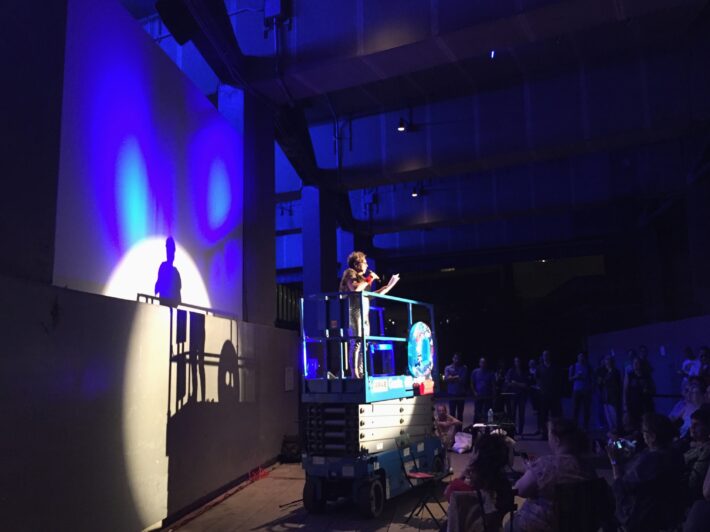
On a hot summer night, Alina Troyano strolled in front of a crowd of about 40 people at the High Line in Chelsea, dressed as Pingalito Betancourt, a Cuban man, in a white short-sleeved button-down shirt, dark dress pants and a brown hat. The crowd was a mixture of older and younger people of different ethnicities.
Pingalito Betancourt started the show with facts about the High Line, a park created on the elevated train tracks that were abandoned in 1980. He continued with facts about Cuba, switching from English to Spanish with ease and often repeating the same Spanish phrase in English for the crowd’s benefit.
Troyano then stripped off the Pingalito Betancourt outfit while dancing to “Single Ladies” by Beyonce to reveal a long animal-print leotard. As her main stage persona, Carmelita Tropicana, she added lipstick, a short animal-print jacket and platform heels.
Troyano — or rather, Tropicana — told stories that involved race, politics and immigration, including the controversial story of Elian Gonzalez, to criticize current immigration laws. The Cuban boy was found at sea in 1999 and taken to his family in Florida, but sent back to Cuba in 2000 at his father’s insistence. While in character, she explained the Cuban Adjustment Act, a law that went into effect in 1966 to give Cuban refugees a path to permanent residency. “Not like the Syrian boys coming in now,” she said.
“I criticized both ways,” Troyano explained after the show. Cubans have valid reasons to leave their country, like many other refugees, but Cubans have a more accessible path to residency in the U.S., she explained. “I want people to think.” As a lesbian in the 1980s, Troyano explored gender and racial issues through comedy and acting in small theater groups in the East Village. She never expected queer trends to go from those small theatrical circles to mainstream media. Troyano is currently working with Branden Jacobs-Jenkins on a project funded by Creative Capital, which provides artists with business support for their art.
The Friends of the High Line, which manages the park with the New York City Department of Parks and Recreation, has sought to attract local residents since the park opened in 2009. Last year, 69 percent of visitors were from out of town, up from 54 percent in 2009.
Solana Chehtman, the public programs manager at the Friends of the High Line, has made it her goal to engage more New Yorkers since she started working for the park about two years ago. In 2015, 31 percent of the visitors were from New York City, according to data from the Friends of the High Line.
“We want to mirror the voices in the city,” Chehtman said. The High Line seeks to attract the nearby LGBT and Latino communities with a new series this year: Out of Line shows are based on the Renegade Cabaret, a series of shows that photographer Patty Heffley hosted on her fire escape on West 20th Street in 2009. The final event, on Thursday, September 22, will feature the Heart-Beat Opera, an opera-singing group that performs in drag.
“We don’t need them to be explicit, but we want them represented,” Chehtman said, who notes that visitors have become more ethnically diverse. In 2010, 21 percent of visitors were non-white and by 2015, that percentage had grown to 34 percent; Asian and Hispanic visitors more than quadrupled in the last five years.
Diversity among event attendees is even greater. So far this year, 64 percent of people who attended the adult programs were non-white. Hispanics accounted for 23 percent of the non-white group, while Asian and African Americans accounted for 14 percent and 13 percent, respectively.
The diversified programming, however, is not for everyone. Kellie Murphy, a Chelsea resident, said these events are not a priority to her because she does not relate to targeted events. She would rather meet her friends elsewhere.
“They’ve come such a long way,” Murphy said about the park’s organizers, but “they could be more inclusive.”
Murphy, who lives on West 28th Street, said the northern part of the High Line lacks art installations and larger social gathering areas like the one where Troyano performed above 14th Street. It is significantly narrower and the larger spaces are cast in shadow by the Hudson Yards construction.
But Troyano insists that the High Line should be for everyone.
“The great thing about New York is that we are all here,” Troyano said as she neared the end of her show. “Some of us are queer and some of us are not.”